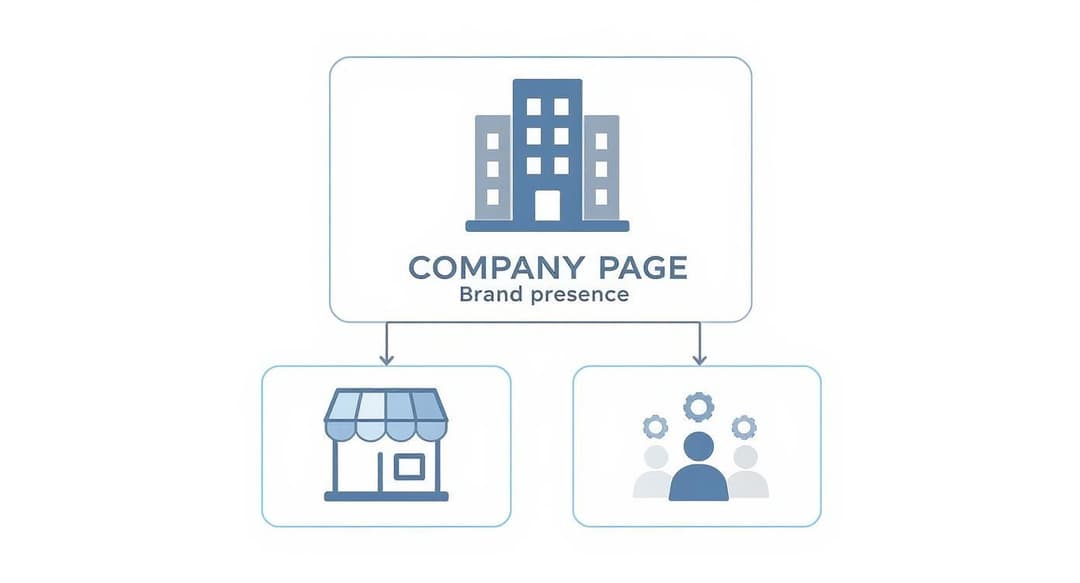Let's think of your main LinkedIn Company Page as your brand's headquarters—it's the central hub for everything you do. A LinkedIn Showcase Page, on the other hand, is like a specialized branch office. It’s a dedicated space designed to serve a specific product line, a unique customer group, or a major company initiative.
These pages are powerful offshoots of your primary brand page, not replacements for it.
So, What Exactly Is a LinkedIn Showcase Page?
One of the biggest headaches for businesses on LinkedIn is trying to talk to everyone at the same time. Your main company page often has to cater to a mix of investors, potential new hires, and several different types of customers. This can water down your message, leaving you with content that's too generic to really connect with anyone.
This is precisely where a Showcase Page strategy comes in.
Showcase Pages allow you to create distinct content streams for specific parts of your business. This means you can deliver super-relevant content, build focused communities, and speak the language of different customer personas without cluttering up your main brand feed. (If you're still sorting out the basics, our guide on the differences between a LinkedIn Company Page and a Personal Profile is a great place to start.)
Think of it like this: your main Company Page is the trunk of the tree, and Showcase Pages are the branches reaching out to specific communities.
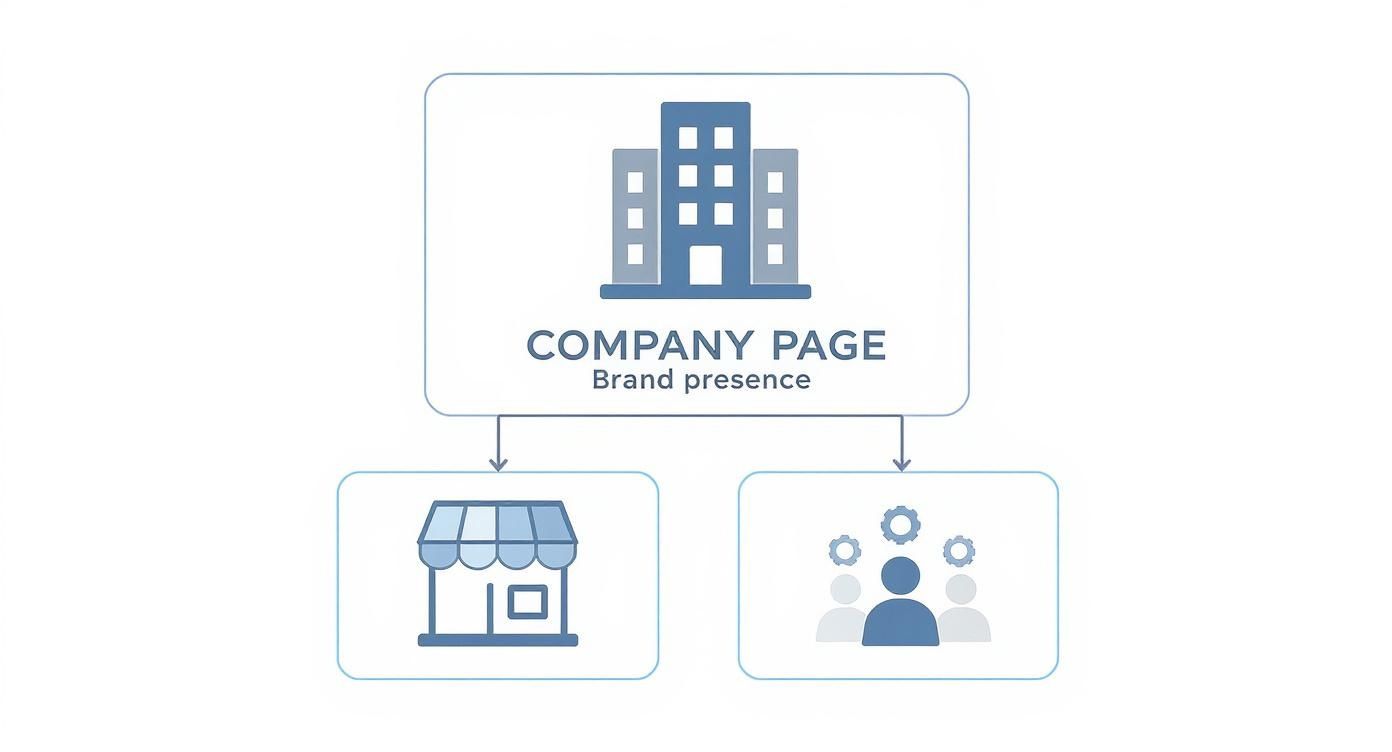
This structure lets you maintain a strong, unified brand identity while creating targeted channels for different business units or initiatives.
Why Does This Segmentation Actually Matter?
Breaking your audience into smaller, more defined groups allows you to create a much more personal and relevant experience for them. Instead of a one-size-fits-all firehose of content, you can tailor your tone and topics for each key segment.
This approach pays off in a few significant ways:
- Deeper Engagement: When your content speaks directly to a niche audience's specific challenges and interests, it naturally gets more likes, comments, and shares. It just hits home harder.
- Clearer Messaging: You can spotlight the features of a specific product or the goals of a particular initiative without confusing your wider audience. For example, a software company could have one page for its developer community and a completely separate one for its enterprise clients.
- Focused Community Building: It helps you attract and nurture a following of people who are genuinely passionate about that specific topic, turning your page into a go-to resource.
LinkedIn actually introduced Showcase Pages way back in 2013 for this very reason—to help companies stop shouting into the void and start having meaningful conversations with the right people.
A Showcase Page isn't just another profile to keep updated. It’s a strategic tool for turning broad brand awareness into focused, high-value engagement. It shifts your LinkedIn presence from a monologue into multiple, targeted conversations.
When Should You Create a Showcase Page?
So you know what a Showcase Page is, but the real question is, when does it actually make sense to create one? This is a crucial step. Rushing to launch a new page for every product or idea can backfire, leaving you with a bunch of neglected pages and wasted effort.
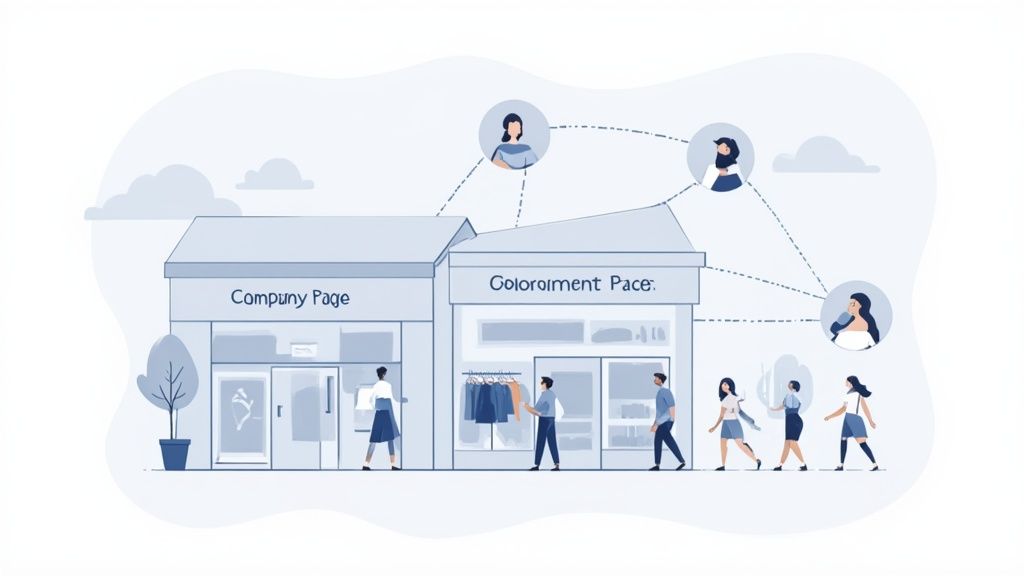
The decision should always be strategic and tied to a specific business goal. You create a Showcase Page when you need to speak directly to a niche audience with its own unique interests and problems—ones that aren't getting the attention they deserve on your main Company Page. When your main feed feels too crowded to connect deeply with a key group, that’s your cue.
Think of it like this: your Company Page is your brand's main stage, where everyone gathers. A Showcase Page is a specialized workshop happening in a breakout room, focused on one specific topic for a dedicated audience. You only host a workshop when the topic is important enough to deserve its own focused conversation.
To Put a Spotlight on a Flagship Product or Service
One of the best and most common reasons to launch a Showcase Page is to give a major product or service its own platform. This works especially well when a single offering targets a very specific buyer, has its own unique story, or needs more detailed content than you can fit on your general page.
Imagine a large software company that sells a whole suite of business tools. Its main page is busy with company-wide news, culture posts, and general updates. But let's say it just launched a powerful AI analytics platform. It could create a Showcase Page just for that product to:
- Share Hyper-Focused Content: Post case studies, how-to guides, and articles that only data analysts and BI professionals would care about.
- Build a Dedicated Community: Attract a following of experts and power users who are passionate about that specific tool.
- Announce Product Updates: Share news about features and improvements without it getting lost in the noise of everything else the company is doing.
This focused strategy helps the company build authority in the analytics space and connect with a high-value audience in a way that feels personal and relevant.
To Target Specific Geographic Markets
Does your business operate in different countries? If so, you know that language and culture matter. A Showcase Page is a fantastic tool for localizing your message. Instead of cluttering your main page with posts in multiple languages, you can create separate pages for each key region.
A global brand speaking to a local audience in their native language is no longer just a courtesy—it’s a competitive advantage. People are far more likely to engage when you communicate with them in the language they actually think and work in.
Companies like Procter & Gamble do this brilliantly. They have pages like "Procter & Gamble España" to connect directly with their Spanish audience. This allows them to run region-specific promotions, share local news, and create content that resonates culturally—things that would feel completely out of place on their global page.
To Build a Community Around a Key Initiative
Showcase Pages aren't just for selling products. They are also incredibly effective for building momentum around a company initiative. Whether you're championing a sustainability program, promoting diversity and inclusion, or supporting a cause, a dedicated page can become the central hub for that conversation.
For instance, a company could launch a "Green Future" Showcase Page to:
- Share updates on its sustainability goals.
- Spotlight employee volunteer work and its community impact.
- Post articles and research about environmental responsibility.
- Attract new talent who are passionate about the company's values.
This approach turns a corporate goal from a line in an annual report into a living, breathing community. It shows you’re serious and invites your followers to join the journey, creating a much stronger brand connection. The bottom line is, if you have a distinct audience and can commit to feeding it with great content, a Showcase Page on LinkedIn is a smart move.
Alright, let's get that polished up. Here’s a more natural, human-sounding version of that section.
How to Create a LinkedIn Showcase Page
So, you've decided a Showcase Page is the right move. Great. Now for the fun part: building it. The process itself is pretty simple, but don't rush through it. Think of this as setting up a specialty shop connected to your main department store—every little detail helps attract the right kind of customer.
First thing's first: you need to be a Super Admin of your main LinkedIn Company Page. If you're not, you won't even see the option to create one.
Getting Started
You'll find the option to create a Showcase Page tucked away inside your main Company Page's admin dashboard. LinkedIn treats these as direct offshoots of your primary brand, so it makes sense that you start there.
Just head to your Admin tools, and you'll see it waiting for you.
As you can see, the "Create a Showcase Page" button is right there in the "Admin tools" dropdown. One click, and you're on your way.
The Step-by-Step Breakdown
Once you hit that button, LinkedIn pops up a form. Filling this out thoughtfully is your first real step toward making the page a success.
- Name Your Page: This is your digital storefront sign. Make it clear and descriptive. If your company is "Innovate Corp" and the page is for your new AI software, something like "Innovate Corp AI Solutions" is perfect. It's instantly recognizable and tells people exactly what they'll find.
- Add Your Website URL: Don't just dump people on your main homepage. Link them directly to the landing page for that specific product, service, or initiative. Make their journey seamless.
- Choose Your Industry: Pick the industry that fits this specific part of your business. This helps LinkedIn put your page in front of the right eyeballs.
- Upload Your Logo and Cover Image: Visuals matter, big time. Your logo should be a crisp, high-quality square. Your cover image (aim for 1128 x 191 pixels) is your billboard. Use it to show off your product, highlight a key benefit, or capture the vibe of your community.
Quick tip: Remember that your Showcase Page can show up in search results on both LinkedIn and Google. A clear, keyword-friendly name and a fully filled-out profile are your best shot at getting discovered for free.
Nailing the "About" Section
With the basics in place, it’s time to tackle the "About" section. This is where you get to tell your story. You’ve got up to 2,000 characters to work with, so use them wisely.
Here’s a simple framework that always works well:
- The Hook: Kick things off with a strong sentence that states who the page is for and what it's all about.
- The Problem: Briefly touch on the challenge or pain point your audience is facing.
- The Solution: Explain how your product, service, or initiative solves that problem.
- The Call to Action: Tell people what to do next. Should they follow the page? Visit your website? Join the discussion? Be direct.
Sprinkle in keywords that your target audience would actually search for, but keep it sounding natural. Once you're happy with it, just click the "Create Page" button. And just like that, your new LinkedIn Showcase Page is live and ready for you to start building a following.
Developing a Winning Content Strategy
A LinkedIn Showcase Page is a fantastic tool, but it's only as good as the content you put on it. Think of the page as an empty stage. It might be beautifully designed, but without a compelling performance—your content—it won't draw a crowd. A page without a smart content strategy is just a digital ghost town, failing to build that focused community you're after.
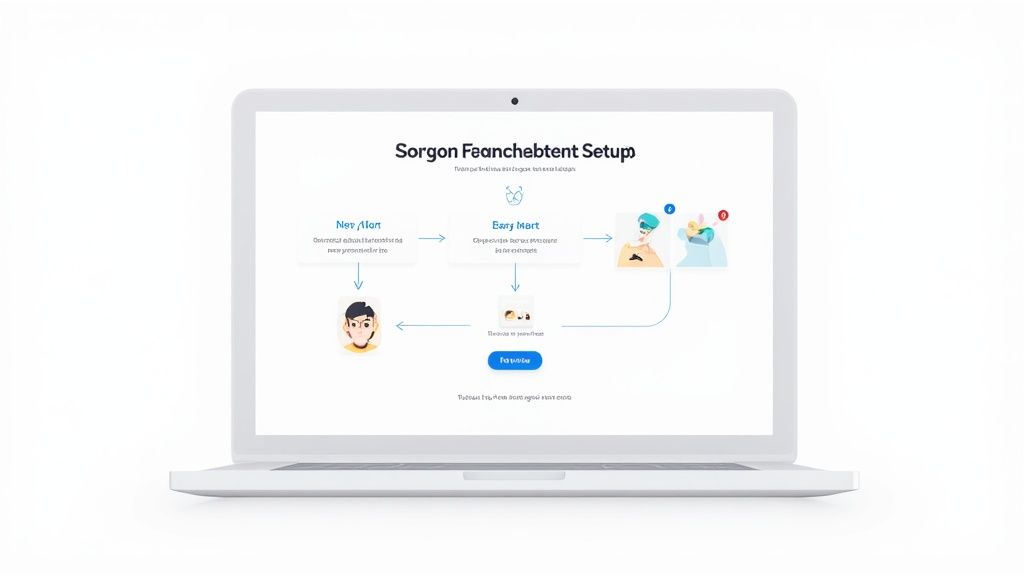
Here’s the most important rule: the content on your Showcase Page absolutely must be different from what’s on your main Company Page. It needs to be hyper-specific and incredibly valuable, speaking directly to the unique interests and challenges of your niche audience. This is your chance to stop broadcasting general brand messages and start having specialized, expert conversations.
Aligning Content with Audience Needs
First things first, circle back to why you created this page. Why does this specific group of people need their own dedicated space? What problems can you help them solve? The answers to these questions will form the pillars of your entire content plan.
To really nail this, you can use techniques like an effective content gap analysis. This process is great for spotting what your audience is looking for versus what you’re actually providing, shining a light on golden opportunities to create content that hits the mark.
Every post you create should aim to do one of these things for your audience:
- Educate: Think in-depth tutorials, best practices, and industry insights that are immediately useful to them.
- Inform: Share exclusive product news, behind-the-scenes content, or relevant updates they can’t get anywhere else.
- Inspire: Post compelling case studies, customer success stories, or creative ways people are using your product.
- Engage: Spark a conversation by asking smart questions, running polls, and creating posts that invite discussion.
This focused approach makes every piece of content count, solidifying your page's reputation as the go-to resource for its topic.
Choosing the Right Content Formats
Variety keeps things interesting. Your main page might have a more corporate, buttoned-up style, but a showcase page on LinkedIn gives you the freedom to get creative and experiment with formats that truly connect with your niche audience.
It's no secret that visual content is king right now. Data shows that multi-image posts—which are perfect for showing off different product features on a Showcase Page—get an average engagement rate of 6.60%. And don't sleep on video; on larger pages, video content pulls in an average of 2,400 views per video, proving it’s a powerhouse for grabbing attention.
The content on your Showcase Page should feel like it was created exclusively for that audience. Generic, one-size-fits-all posts will quickly erode the trust and focus you're trying to build.
Try mixing these formats into your content calendar:
- Multi-Image Posts: Great for step-by-step guides, highlighting key features, or giving a recap of an event.
- Short-Form Video: Perfect for quick product demos, expert tips, or authentic customer testimonials.
- In-Depth Articles: Use LinkedIn Articles to publish long-form content like deep-dive case studies to really establish your authority.
- Polls and Questions: Get your community talking by asking for their opinions on topics they genuinely care about.
Establishing a Consistent Posting Cadence
Consistency builds trust and habit. An active, predictable schedule shows your followers that your page is a living, breathing resource, not some forgotten project. You don't have to post every single day, but you do need to find a sustainable rhythm.
Start with a manageable goal, like posting 2-3 times per week. The goal is consistent quality over sporadic quantity. Using a scheduling tool is a lifesaver here, as it helps you maintain this cadence without the daily scramble. For more on this, our guide to building a https://postiz.com/blog/linkedin-marketing-strategy offers practical tips on planning and executing.
This disciplined approach will keep your page top-of-mind, turning it from just another profile into a thriving hub that your followers visit regularly for valuable, relevant content.
How to Measure Your Showcase Page Performance
You’ve built a great-looking Showcase Page and have a solid content plan in place. That’s a fantastic start, but it’s really only half the job. To make sure all that effort is paying off, you need to know what's connecting with your audience and what's falling flat. This is where you stop guessing and start making smart, data-driven decisions.
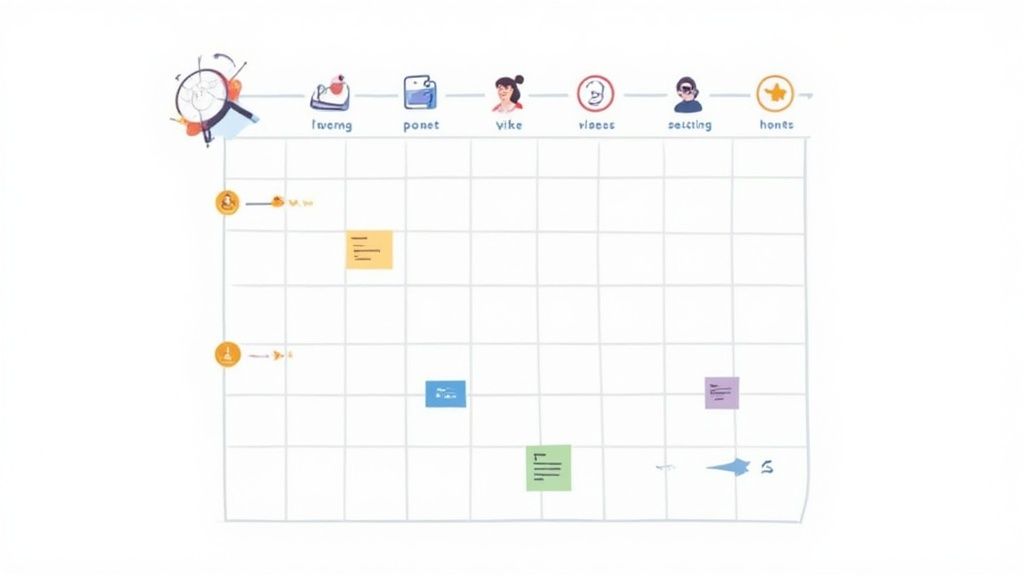
Thankfully, LinkedIn gives each Showcase Page its very own analytics dashboard, completely separate from your main Company Page. This is a huge advantage because it means your data stays clean—no mixed signals. Think of it as a dedicated report card for your niche initiative, showing you exactly how that specific audience is reacting.
Key Metrics to Monitor
When you first open up your Showcase Page analytics, it’s easy to feel a bit overwhelmed by all the data. The trick is to focus on the numbers that tell the real story of your page’s health and growth.
Here are the essential metrics to keep an eye on:
- Follower Demographics and Growth: Who is actually following your page? This section breaks it down by job title, industry, and seniority. Watching this is critical. A steady climb in followers from your target group is a strong signal that your content is landing just right.
- Update Analytics: This is the nitty-gritty of your individual posts. Look at impressions (how many people saw your content), clicks, comments, reactions, and the all-important engagement rate. These numbers tell you what’s grabbing attention.
- Visitor Analytics: This data reveals who’s stopping by your page, even if they haven’t hit the "Follow" button yet. Understanding their demographics can show you if your page is being discovered by the right professionals through search or shares.
Tracking these numbers isn't just about record-keeping. It's about piecing together the narrative of what your audience truly cares about. For a more comprehensive look at this, our complete guide on mastering social media analytics and reporting will help you build a bulletproof framework.
Turning Insights into Actionable Strategy
The real magic happens when you use this data to make better decisions. A post with high engagement isn’t just a nice win; it’s a clue. It’s your audience telling you exactly what topics, formats, and voices they want to hear more of.
Don't just look at what performed well—look at why. Was it the topic? The visual? The question you asked? Deconstructing your successes is the fastest way to replicate them.
Use what you learn to constantly tweak your approach. If you see that short video tutorials get three times the engagement of your text-only posts, it’s a no-brainer to make more videos. If follower numbers spike every time you address a specific industry pain point, you've just found a content goldmine.
This cycle of posting, measuring, and refining turns your showcase page on LinkedIn from a simple broadcast channel into a fine-tuned engine for community engagement.
Examples of Great LinkedIn Showcase Pages
Theory is great, but seeing a showcase page on LinkedIn in the wild is where the real lightbulb moments happen. Let's take a look at how some of the biggest brands use these pages to connect with very specific audiences, build authority, and hit their business goals.
By breaking down what they do well, you can steal their best ideas and adapt them for your own strategy. Don't be fooled by the big names; the principles they use work for businesses of any size.
Adobe Creative Cloud
Adobe is a huge company with a ton of different products. Their "Adobe Creative Cloud" page is a masterclass in how to focus. Instead of cluttering the feed with corporate news, it's a vibrant hub built just for designers, photographers, and video editors.
So, what makes it work so well?
- Hyper-Relevant Content: The entire feed is full of tutorials, artist spotlights, design challenges, and practical tips for using Creative Cloud apps. It speaks directly to its creative audience in their own language.
- Strong Visual Identity: The page pops with a bold, colorful style that perfectly reflects the creativity it’s all about. This branding is completely distinct from the main Adobe corporate page, giving it a life of its own.
- Community Building: Adobe doesn't just talk at its followers; it encourages them to share their work and jump into conversations. This transforms the page from a simple marketing channel into a genuine collaborative space.
Microsoft for Startups
Microsoft’s main page has to appeal to everyone, from Fortune 500 executives to regular home PC users. To reach a very specific and valuable group, they launched the "Microsoft for Startups" Showcase Page.
This page brilliantly zooms in on the unique challenges and needs of new companies.
The real magic of a Showcase Page is making a small, targeted audience feel like they're your main priority. Microsoft for Startups nails this by cutting out all the corporate noise and focusing 100% on resources for founders.
The content is perfectly tailored. You'll find founder stories, advice on getting funding, and technical guides for building a business from the ground up. It’s a fantastic example of using a showcase page linkedin to serve a niche market, positioning Microsoft as a go-to partner in the startup world.
This focused approach lets them build real relationships with the tech leaders of tomorrow in a way their main page never could. By delivering immense value to this specific group, they're building loyalty long before these startups grow into huge enterprise clients. It's a perfect case study on the long-term strategic power of a well-run Showcase Page.
Common Questions About Showcase Pages
As you get ready to launch a show-off page on LinkedIn, you’ll likely have a few questions bubble to the surface. Let's clear up some of the most common ones so you can move forward with confidence.
First things first: what's this going to cost? The great news is that creating a LinkedIn Showcase Page is completely free. There's no fee to set it up. Your only real investment is the time and effort you put into crafting great content that speaks directly to your new, focused audience.
How Many Pages Should You Create?
LinkedIn lets you create up to 25 Showcase Pages for each main Company Page, but this is definitely a "less is more" situation. Don't fall into the trap of creating a bunch of pages you can't keep up with. A neglected page with stale content is worse than no page at all.
The golden rule is simple: only create a Showcase Page if you have a distinct audience and a dedicated content plan to serve them. Start with one or two well-managed pages before considering more.
Most businesses find their sweet spot by focusing on a few key areas:
- A flagship product with its own dedicated community of users.
- A major corporate initiative, like sustainability efforts or a diversity program.
- A key geographic market that needs content in a different language or with a local focus.
Promoting and Growing Your New Page
Your new Showcase Page will start with zero followers, so you'll need a solid plan to get the word out. Just building it and hoping people stumble upon it won't work.
Think of it like a grand opening—you have to invite people. A multi-channel approach is your best bet:
- Announce it on your Company Page: Your main page is the perfect launchpad. Tell your existing followers about the new, specialized page and who it’s for.
- Email Your Subscribers: Let your email list know you've built a new community just for them on LinkedIn.
- Cross-Promote on Other Socials: Share the news on your other social media channels to bring relevant followers over.
- Employee Advocacy: Get your team involved! Encourage them to follow the new page and share its content with their own networks.
And yes, you can absolutely run paid ads to promote a showcase page on LinkedIn. You can run follower campaigns to build that initial audience from scratch or boost your best-performing posts to get them in front of the right people. It's a fantastic way to kickstart growth and make sure your specialized content doesn't get lost in the noise.
Ready to manage your new Showcase Page like a pro? Postiz provides all the tools you need to schedule content, analyze performance, and engage your community without the chaos. Start streamlining your social media workflow today at https://postiz.com.

